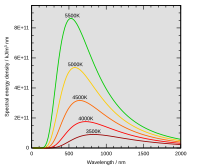
Photo from wikipedia
Objects around us constantly emit and absorb thermal radiation. The emission and absorption processes are governed by two fundamental radiative properties: emissivity and absorptivity. For reciprocal systems, the emissivity and… Click to show full abstract
Objects around us constantly emit and absorb thermal radiation. The emission and absorption processes are governed by two fundamental radiative properties: emissivity and absorptivity. For reciprocal systems, the emissivity and absorptivity are restricted to be equal by Kirchhoff's law of thermal radiation. This restriction limits the degree of freedom to control thermal radiation and contributes to an intrinsic loss mechanism in photonic energy harvesting systems. Existing approaches to violate Kirchhoff's law typically utilize magneto-optical effects with an external magnetic field. However, these approaches require either a strong magnetic field (~3T), or narrow-band resonances under a moderate magnetic field (~0.3T), because the non-reciprocity in conventional magneto-optical effects is weak in the thermal wavelength range. Here, we show that the axion electrodynamics in magnetic Weyl semimetals can be used to construct strongly nonreciprocal thermal emitters that near completely violate Kirchhoff's law over broad angular and frequency ranges, without requiring any external magnetic field.
Journal Title: Nano letters
Year Published: 2020
Link to full text (if available)
Share on Social Media: Sign Up to like & get
recommendations!